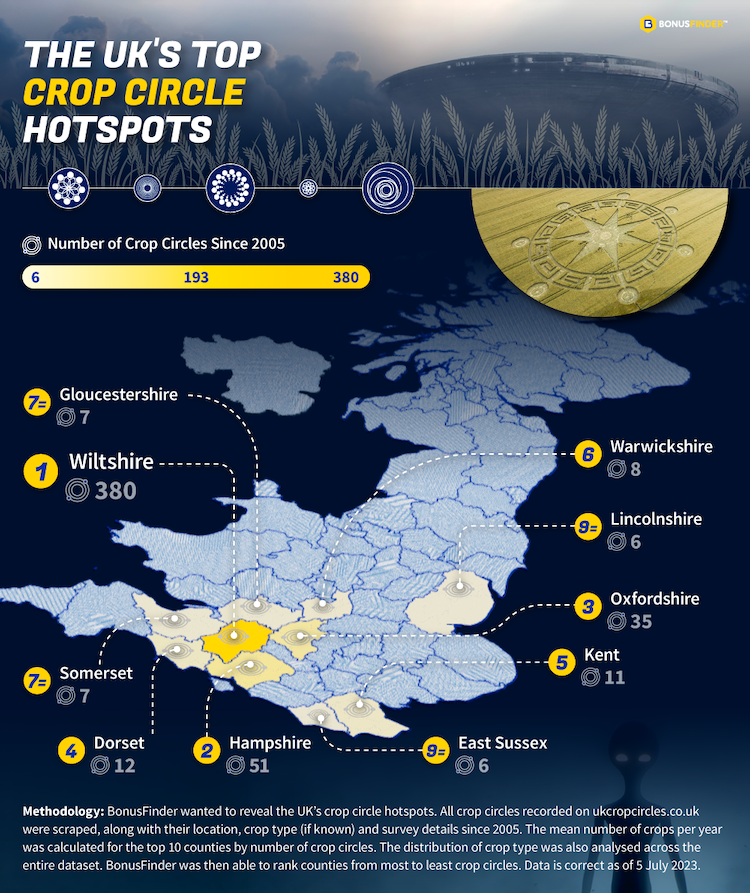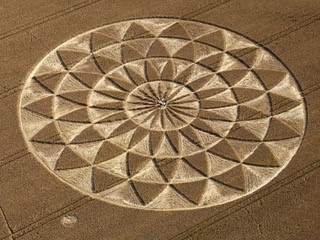Veiled in mystery, crop circles multiply relentlessly, with an average of 30 formations emerging annually in the UK. Crop circle enthusiasts attribute them to ley lines—ancient pathways aiding navigation—while others perceive them as extraterrestrial messages, cautioning humanity about perils like climate change and nuclear war.
With this in mind, BonusFinder were intrigued to find out which counties across the UK boast the greatest abundance of these mysterious formations? They scraped records of crop circles since 2005, along with their location, crop type, and survey details in order to establish the county with the highest number of crop circles.
BonusFinder also collaborated with Monique Klinkenbergh, researcher and founder of the Crop Circle Visitor Centre & Exhibition, to help unveil some of the mystery surrounding crop circles.
Wiltshire is the UK crop circle hotspot! With its idyllic villages and the iconic Salisbury Cathedral, it surpasses all other counties, boasting a staggering 380 crop circles since 2005.
The South East county of Hampshire follows in second place with 51 crop circles.
It's official! Wiltshire is the UK’s crop circle hotspot with an impressive 380 crop circles having appeared in the county since 2005. Crop circles in Wiltshire often emerge in fields of wheat and barley where shapes are flattened into the vegetation. The county’s idyllic rolling hills and farming land provide the ideal framework for these creations. The most recent formation in the county was observed on the 28th of May 2023 in Broad Hinton and is described as a six-fold spinner with standing 'arms' within a laid circle and a central unbroken ring of standing stems with a flattened centre.
The South East county of Hampshire comes second with 51 crop circles. Known for the historical Winchester Cathedral and expansive countryside, Hampshire is an ideal location for these mysterious formations. The designs range from simple circles and rings to elaborate patterns. The village of Chilcomb in Hampshire saw the most recent formation on the 12th of July 2022 with a series of laid circles and rings contained within a narrow outer ring.
In third place is the county of Oxfordshire with 35 crop circles recorded. Once again, the scenic countryside offers a perfect landscape for these formations with complex geometric designs leaving crop circle enthusiasts amazed. The most recent formation was discovered on the 9th of August 2020 in Uffington Castle and is described as a wheat formation with concentric, rotating, triangular elements around the central circle and standing ring.
Monique Klinkenbergh, researcher and founder of the Crop Circle Visitor Centre & Exhibition, gives insight into why Wiltshire is the UK’s crop circle capital:
- What is the reason for the prevalence of crop circles in Wiltshire?
“Crop circles seem to be attracted by ancient sites such as stone circles, long barrows, hill forts and other archaeological sites, for which Wiltshire is famous. One of the earliest theories for this attraction is the idea that what has been built by our distant ancestors on ancient sites, marked by what has always been part of the landscape: Earth Energies. Those energies - the so called ley-lines - are said to run invisibly through the landscape concentrating at crossing points where they also emerge to the surface. Experienced dowsers report detectable energetic changes within crop circles.
The Underground Connection, another theory on why Wiltshire is a focus-point for crop circle activity, describes the presence of chalk and green sand rock in combination with large aquifers. The high mineral content of the major aquifers of England makes them good conductors of electricity, possibly derived through interaction with the Earth’s electromagnetic field. The alkaline chalk is saturated with water. Beneath is a lint-rich clay and the top ridges of the chalk Downs are topped by a thin layer of lint. Therefore there is an alkaline solution sandwiched on either side by acidic layers. The theory of Broughton and Page is that this attracts and is then activated and ‘charged up’ by the powerful currents of energy flowing through the ground.”
- What are the types of crop circles you tend to see in Wiltshire?
“We have had so many different designs appearing, from small simple circles and ‘pictograms’ to extremely intricate and large patterns. Sometimes with a very detailed and complex lay on the ground (lay: the way the plants are laid down). Some crop circle patterns are familiar in design, suggesting they belong to a certain ‘school’ or ‘family-type’, such as Mathematical, Forms of Life, Religious, Astronomical, Codes and Mythology.”
- How are crop circles formed?
"Besides the man-made crop circles, there are many ideas, hypotheses and theories of how the ‘unexplained' crop circles form, ranging from extraterrestrial involvement, the paranormal, spirits of the dead, the universe, sound frequencies (recorded on tape), balls of light (recorded on camera) and nature itself. They might be all interconnected. The eyewitness reports (50+ credible accounts) all have one thing in common - the crop flattening process is described as happening in a matter of seconds and being done by an invisible source. One hypothesis regarding the origin of crop circles - a theory which all researchers agree on - is that some could be the result of an ‘interaction’ between a person’s thoughts and the energy/force that forms the crop circle. There are many reports of people who requested or wished for a crop circle to be manifested for them and finding one had appeared. Some experiments have been successful and may open a new way of understanding the principles at work.”
- What tools do you suspect are used?
“The man-made tools that are used are planks and ropes. Also, some believe that crop circles are made by hidden agencies using space satellite lasers or other science fiction devices to conduct training, environmental control or simply to study how people will react.”
You may also be interested in Crop Circles, Murder & More!


